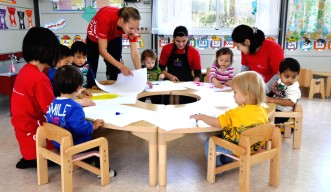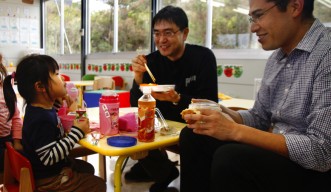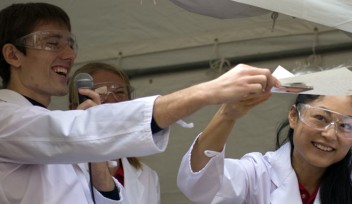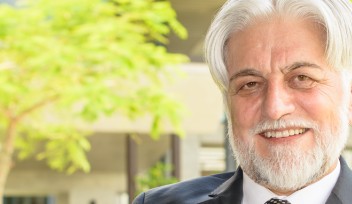OIST’s Tedako Preschool Opens its Doors
On Monday, January 7, 2013, OIST’s Preschool program opened its doors to the children of the OIST community. The Afterschool program, which is housed in the Village Center Building, has been in operation since October 2012. The two programs, formerly known as the Child Development Center, have been renamed Tedako, which means 'children of the sun' in the local Okinawan dialect. After the construction of a temporary, prefabricated building and the hiring of six teachers and three teacher’s aids, OIST’s preschool is on the fast track to becoming an integral part of life at the university.
“I was exhilarated when I visited Tedako on the morning of January 7, where I saw the children of parents from all sectors of the university in a stimulating environment and under the care of loving and highly professional teachers and caregivers,” said OIST President, Jonathan Dorfan. “Julia Nabholz – the Acting Director of Tedako, her staff, the OIST Childcare Association and the Child Development Center Board of Governors are to be congratulated for establishing such an invaluable asset to our university.”
Though the number is growing all the time, 37 children, aged two months to five years old, had their first day of school on January 7. In April of this year 16 more registered students will begin their preschool program and an additional kindergarten class will be opened to accommodate the needs of OIST parents with older children. With Tedako already nearing its capacity, the need for childcare will continue to grow as the university grows. OIST hopes to build a larger, more permanent facility and hire more staff in the future.
The preschool is open from 8:00 to 18:00, Monday through Friday, but activities start at 9:00 and end at 17:00. Tedako teachers can care for children on a part-time, full-time or hourly basis, depending on the needs of the parents. The program is also resolutely bi-lingual: during instruction, each teacher will only speak either English or Japanese without translating. Students will be asked to speak to the teacher in the language of instruction, but may use their peers as resources. During free playtime, children will be able to interact in the language of their choice. “Though the children’s routines and daily schedules will remain the same,” said Nabholz, “the language of instruction will alternate on a bi-weekly basis to ensure equal exposure to both languages.”
“We were amazed the first time we visited Tedako,” said Yong Yang, a researcher in the Light-Matter Interactions Unit, and his wife Quinn Yang. “Our son is in the infant class and the room he plays in is very nice, neat, quiet, safe and comfortable. We made a very good decision to send our baby to Tedako.”
One of the best things about Tedako, however, was summed up by Kenichi Sajiki a post-doctoral researcher in G0 Cell Unit, whose daughter is participating in the program: “Whenever you have time, at lunch or otherwise, it’s easy to walk over and visit your daughter or son. It’s nice not being far away.”
“If there are any problems with my son, I can quickly interrupt my work, deal with it, and immediately resume work afterwards,” adds Zacharie Taoufiq, a researcher in the Cellular and Molecular Synaptic Function Unit at OIST. “It is just priceless to have him so close.”
For press enquiries:
Press Inquiry Form















